A Closer Look At Cost Sharing
A major annual survey reveals distinct patterns in the amounts and methods that employers are using to pass along increased health care costs.
A Closer Look At Cost Sharing
A major annual survey reveals distinct patterns in the amounts and methods that employers are using to pass along increased health care costs.
By Richard Service, Managing Director
The Business & Health Institute
Health insurance premiums recorded their biggest increases in more than a decade this year, and small firms got hit coming and going. They generally experience higher premium increases because they lack the bargaining clout of their bigger brethren, and they are also less willing or less able to pass along those increases to employees.
This year, for instance, 56 percent of large firms increased the worker share of monthly premiums compared with only 29 percent of those with less than 2,000 workers. Forty two percent of the smaller firms plan to pass along a bigger share of premium next year, but 78 percent of big firms will take that route.
Similar patterns are found in deductibles and copays, as reported in the 2002 edition of the Employer Health Benefits Survey from the Kaiser Family Foundation and the Health Research and Educational Trust (originally reported in B&H's News & Trends of September 18, 2002).
The survey also found that small firms ask their employees to spend less out-of-pocket before insurance kicks in. One disconcerting finding: A significant percentage of small firm respondents didn't know what out-of-pocket limit they'd set for their employees.
Most firms have not resorted to reducing benefits, but more of them are now choosing to go that course: 17 percent this year vs. 7 percent in 2000. Ten percent of all firms actually increased their benefits this year.
No matter what their size, only 2 percent of firms have restricted eligibility for coverage, and a mere 5 percent of small firms and percent of large firms think they might drop coverage completely next year.
Sixteen percent of all firms might restrict eligibility for coverage if the economy does not recover next year, while 18 percent might do so in the face of a premium increase of 20 percent. Eight to 10 percent of small firms would stop offering coverage in those scenarios, but only 2 percent of large employers would consider bailing out.
The 180-page survey report also describes trends in prescription drug copays and formularies as well as tiered copays for doctors and hospital visits. Highlights are presented below.
The shrinking employee share of premium

Conventional & HMO
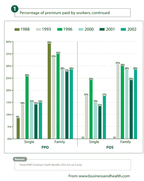
PPO & POS
Cost sharing strategies at large and small firms
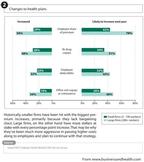
Raising the out-of-pocket ante
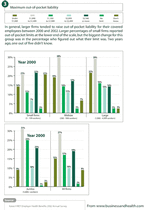
2000
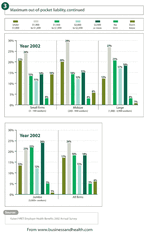
2002
Tiered copays spread from prescriptions to providers
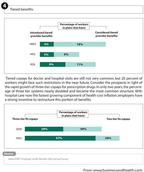
The widening spread of RX copays
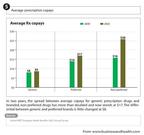
Formularies gain across the board

Click here for the complete Kaiser/HRET survey.
Richard Service. A Closer Look At Cost Sharing.
Business and Health
2002;13.
Conversations With Perry and Friends: Paul Fronstin, Ph.D.
May 9th 2025Perry Cohen, Pharm.D., a longtime member of the Managed Healthcare Executive editorial advisory board, is host of the Conversations with Perry and Friends podcast. In this episode, his guest is Paul Fronstin, Ph.D., director of health benefits research at the Employee Benefit Research Institute.
Listen
Conversations With Perry and Friends
April 14th 2025Perry Cohen, Pharm.D., a longtime member of the Managed Healthcare Executive editorial advisory board, is host of the Conversations with Perry and Friends podcast. His guest this episode is John Baackes, the former CEO of L.A. Care Health Plan.
Listen
PBM Transparency: Can It Be More Than a Buzzword?
July 1st 2025Employers, some lawmakers and others have criticized pharmacy benefit managers (PBMs), especially the "big three," for having complicated, sometimes hidden practices. The PBMs say they have responded with programs and policies that add transparency to what they do.
Read More